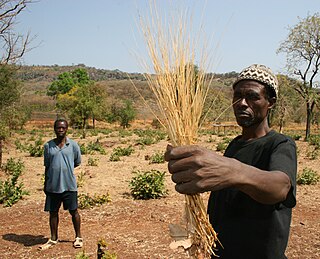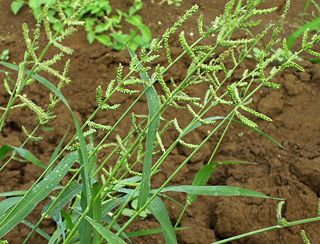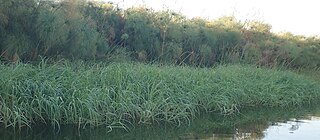
Millets are a highly varied group of small-seeded grasses, widely grown around the world as cereal crops or grains for fodder and human food. Most millets belong to the tribe Paniceae.

Teff, also known as Eragrostis tef, Williams lovegrass, or annual bunch grass, is an annual grass, a species of lovegrass native to Ethiopia, where it first originated in the Ethiopian Highlands. It is cultivated for its edible seeds, also known as teff. Teff was one of the earliest plants domesticated. It is one of the most important staple crops in Ethiopia.

Fonio, also sometimes called findi or acha, is the term for two cultivated grasses in the genus Digitaria that are important crops in parts of West Africa. The nutritious food with a favorable taste is a vital food source in many rural areas, especially in the mountains of Fouta Djalon, Guinea, but it is also cultivated in Mali, Burkina Faso, Ivory Coast, Nigeria, and Senegal. The global fonio market was estimated at 721,400 tonnes in 2020. Guinea annually produces the most fonio in the world, accounting for over 75% of the world's production in 2019. The name fonio is from Wolof foño. In West Africa, the species black fonio (Digitaria iburua) and white fonio (Digitaria exilis) are cultivated; the latter is the economically more important crop.

The Inner Niger Delta, also known as the Macina or Masina, is the inland river delta of the Niger River. It is an area of fluvial wetlands, lakes and floodplains in the semi-arid Sahel area of central Mali, just south of the Sahara Desert.

Echinochloa frumentacea is a species of Echinochloa. Both Echinochloa frumentacea and E. esculenta are called Japanese millet. This millet is widely grown as a cereal in India, Pakistan, and Nepal. Its wild ancestor is the tropical grass Echinochloa colona, but the exact date or region of domestication is uncertain. It is cultivated on marginal lands where rice and other crops will not grow well. The grains are cooked in water, like rice, or boiled with milk and sugar. Sometimes it is fermented to make beer. While also being part of staple diet for some communities in India, these seeds are, in particular, eaten during religious fasting. For this reason, these seeds are commonly also referred to as "vrat ke chawal" in Hindi. Other common names to identify these seeds include oodalu (ಊದಲು) in Kannada, Shyamak (শ্যামাক) or Shyama Chal in Bangla, jhangora in the Garhwal Hills, bhagar (भगर) in Marathi-speaking areas, samo or morio seeds in Gujarati, bonthasaamalu (బొంతసామలు) in Telugu, and kuthiraivaali (குதிரைவாளி) in Tamil.

Echinochloa esculenta or Echinochloa utilis is a type of millet originating from East Asia, and is part of the Poaceae family, making it a grass. E. esculenta is colloquially known as Japanese millet, but possesses many other names, such as: Japanese barnyard millet, marsh millet, Siberian millet, and white millet. Its primary usage in the USA is for forage and for wildlife habitats. In Japan, Korea and northeastern China, the millet is grown on a small scale primarily for fodder. Japanese millet is not a main cereal crop, and is therefore considered an alternative crop.

Echinochloa colonum, commonly known as jungle rice, wild rice, deccan grass, jharua or awnless barnyard grass, is a type of wild grass originating from tropical Asia. It was formerly classified as a species of Panicum. It is the wild ancestor of the cultivated cereal crop Echinochloa frumentacea, sawa millet. Some taxonomists treat the two taxa as one species, in which case the domesticated forms may also be referred to as E. colonum.

Echinochloa is a very widespread genus of plants in the grass family and tribe Paniceae. Some of the species are known by the common names barnyard grass or cockspur grass.

Echinochloa crus-galli is a type of wild grass originating from tropical Asia that was formerly classified as a type of panicum grass. It is commonly known as cockspur, barnyard millet, Japanese millet, water grass, common barnyard grass, or simply "barnyard grass". This plant can grow to 1.5 m in height and has long, flat leaves which are often purplish at the base. Most stems are upright, but some will spread out over the ground. Stems are flattened at the base. The seed heads are a distinctive feature, often purplish, with large millet-like seeds in crowded spikelets.

Lake Débo is a lake in the central part of Mali, formed by the seasonal flooding of the Niger River basin. It is in the Inner Niger Delta of the Niger River. During high water stages of the river, the delta formed by lakes, creeks, and backwaters form part of Lake Débo. The inner delta has many wide channels, which are shallow and flooded marshes; this delta extends over a length of 320 kilometres with a width of 80 km (50 mi). Lake Débo during high flow season, is at a distance of 80 km (50 mi) from Mopti on its upstream, on the southern end and 240 km (150 mi) from Timbuktu at its downstream, on the north-eastern end. It is the largest of many such seasonal wetlands and lakes which form the Inner Niger Delta, and the largest lake within Mali. Its size is largely reduced during the dry season of September to March. The existence of this lake called the "Great Lake" in the inner delta of Niger River between Jenne and Timbuktu in Mali has been established after extensive study of maps of the region extending over a period from 1000 to 1900 AD; 400 maps were studied for the period.

Themeda triandra is a species of C4 perennial tussock-forming grass widespread in Africa, Australia, Asia and the Pacific. In Australia it is commonly known as kangaroo grass and in East Africa and South Africa it is known as red grass and red oat grass or as rooigras in Afrikaans. Kangaroo grass was formerly thought to be one of two species, and was named Themeda australis.

Setaria is a widespread genus of plants in the grass family. The name is derived from the Latin word seta, meaning "bristle" or "hair", which refers to the bristly spikelets.

Barley, a member of the grass family, is a major cereal grain grown in temperate climates globally. It was one of the first cultivated grains; it was domesticated in the Fertile Crescent around 9000 BC, giving it nonshattering spikelets and making it much easier to harvest. Its use then spread throughout Eurasia by 2000 BC. Barley prefers relatively low temperatures and well-drained soil to grow. It is relatively tolerant of drought and soil salinity but is less winter-hardy than wheat or rye.

Maize, also known as corn in North American English, is a tall stout grass that produces cereal grain. It was domesticated by indigenous peoples in southern Mexico about 9,000 years ago from wild teosinte. Native Americans planted it alongside beans and squashes in the Three Sisters polyculture. The leafy stalk of the plant gives rise to male inflorescences or tassels which produce pollen, and female inflorescences called ears. The ears yield grain, known as kernels or seeds. In modern commercial varieties, these are usually yellow or white; other varieties can be of many colors.

Vossia is a monotypic genus in the grass family, found in Asia and Africa. The only known species is Vossia cuspidata, an aquatic grass native to Africa, and to Assam, Bangladesh, and northern Indochina. The common name is hippo grass.

Digitaria iburua, commonly known as iburu, is a grass species native to west and west-central tropical Africa, which is cultivated as a grain crop known as black fonio.
Hippo grass is a common name for several plants and may refer to:

Echinochloa pyramidalis is a species of large grass, occurring naturally in flooded regions and beside lakes in tropical Africa and America, and introduced to various other countries. It is commonly known as antelope grass.

Urochloa ramosa, the browntop millet or Dixie signalgrass, is an annual, millet grass belonging to the grass family (Poaceae). The native range of Urochloa ramosa is from Africa to tropical and subtropical Asia.


















